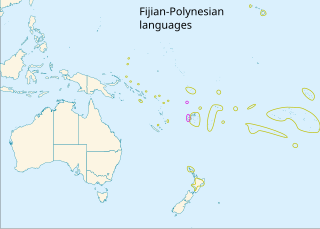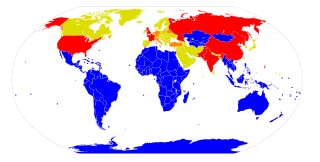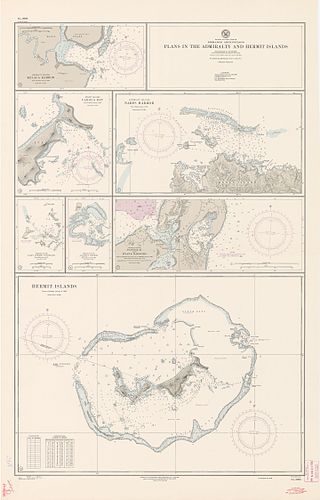
Oceania is a geographical region that is described as a continent in some parts of the world. It includes Australasia, Melanesia, Micronesia, and Polynesia. Spanning the Eastern and Western Hemispheres, Oceania is estimated to have a land area of 8,525,989 square kilometres (3,291,903 sq mi) and a population of around 44.5 million as of 2021. While in most of the English-speaking world Oceania is described as a geographical region, outside of the English-speaking world Oceania is described as one of the continents. In this model of the world, Australia is only seen as an island nation contained inside of the continent of Oceania, and not a continent by itself. When compared to the other continents, Oceania is the smallest in land area and the second least populated after Antarctica.

Melanesia is a subregion of Oceania in the southwestern Pacific Ocean. It extends from New Guinea in the west to the Fiji Islands in the east, and includes the Arafura Sea.

The Polynesian languages form a genealogical group of languages, itself part of the Oceanic branch of the Austronesian family.

Bellona Island is an island of the Rennell and Bellona Province, in the Solomon Islands. Its length is about 10 km (6.2 mi) and its average width 2.5 km (1.6 mi). Its area is about 17 km2 (6.6 sq mi). It is almost totally surrounded by 30–70 m (100–230 ft) high cliffs, consisting primarily of raised coral limestone.

Near Oceania is the part of Oceania settled 35,000 years ago, comprising Australia, New Guinea, and north-western Island Melanesia: the Bismarck Archipelago and the Solomon Islands.

Melanesians are the predominant and indigenous inhabitants of Melanesia, in a wide area from New Guinea to the Fiji Islands. Most speak either one of the many languages of the Austronesian language family, especially ones in the Oceanic branch, or from one of the many unrelated families of Papuan languages. Other languages are the several creoles of the region, such as Tok Pisin, Hiri Motu, Solomon Islands Pijin, Bislama, and Papuan Malay.
The Samoic–Outlier languages, also known as Samoic languages, are a purported group of Polynesian languages, encompassing the Polynesian languages of Samoa, Tuvalu, American Samoa, Tokelau, Wallis and Futuna, and Polynesian outlier languages in New Caledonia, the Solomon Islands, Vanuatu, Papua New Guinea, and the Federated States of Micronesia. The name "Samoic-Outlier" recognizes Sāmoan.

Polynesian outliers are a number of culturally Polynesian societies that geographically lie outside the main region of Polynesian influence, known as the Polynesian Triangle; instead, Polynesian outliers are scattered in the two other Pacific subregions: Melanesia and Micronesia. Based on archaeological and linguistic analysis, these islands are considered to have been colonized by seafaring Polynesians, mostly from the area of Tonga, Samoa and Tuvalu.

Taumako is the largest of the Duff Islands, in the Solomon Islands. This 5.7-kilometre-long (3.5-mile) island has steep sides and rises to a height of 400 metres above sea level. It is composed of basaltic lavas and pyroclastics like the other islands in the Duffs.

Nukuoro is an atoll in the Federated States of Micronesia. It is a municipality of the state of Pohnpei, Federated States of Micronesia. It is the secondmost southern atoll of the country, after Kapingamarangi. They both are Polynesian outliers. As of 2007, Nukuoro had a population of 372, though several hundred Nukuorans live on Pohnpei. Fishing, animal husbandry, and agriculture are the main occupations. A recent project to farm black pearl oysters has been successful at generating additional income for the island's people.

UTC+10:00 is an identifier for a time offset from UTC of +10:00. This time is used in:

The Treaty of Rarotonga is the common name for the South Pacific Nuclear Free Zone Treaty, which formalises a nuclear-weapon-free zone in the South Pacific. The treaty bans the use, testing, and possession of nuclear weapons within the borders of the zone.
The Nukuoro language is a Polynesian Outlier language, spoken by about 1,200 people on Nukuoro Atoll and on Pohnpei, two islands of Pohnpei State within the Federated States of Micronesia. Nukuoro is a remote coral atoll with a population of about 150, where the primary language is Nukuoro. An additional several hundred Nukuoro speakers live in Kolonia, Pohnpei, with smaller diaspora communities elsewhere in Micronesia and in the United States. Most Nukuoro speakers, particularly those that live away from Nukuoro Atoll, are multilingual in Pohnpeian and/or English; some older Nukuoro speakers also know German or Japanese.
Mortlock Islands can refer to:

Richard Parkinson full name Richard Heinrich Robert Parkinson was a Danish explorer and anthropologist.

The Ninigo Islands are a group of 31 islands within the Western Islands of the Bismarck Archipelago, Papua New Guinea. Their coordinates are 1°16′S144°15′E.

The Hermit Islands are a group of 17 islands within the Western Islands of the Bismarck Archipelago, Papua New Guinea. Their coordinates are 1°30′S145°4′E.
Nuguria (Nukuria) was a Polynesian language, spoken by approximately 550 people on Nuguria in the eastern islands of Papua New Guinea. The language was taught in primary schools in Nuguria and was used for daily communications between adults and children. Nuguria is one of the eighteen small islands to the east of Papua New Guinea, which are known as the Polynesian Outliers. The Nukuria language has been concluded to be closely related to other nearby languages such as Nukumanu, Takuu, Nukuoro, and Luangiua. Research on the Nuguria Atoll and the language itself is scarce; past research demonstrated that this language was at risk of potential endangerment. The language was only then classified as at risk of endangerment because it was still used between generations and was passed on to the children. However, recent research indicates that Nukuria is now most likely an extinct language.

The cuisines of Oceania include those found on Australia, New Zealand, and New Guinea, and also cuisines from many other islands or island groups throughout Oceania.
















